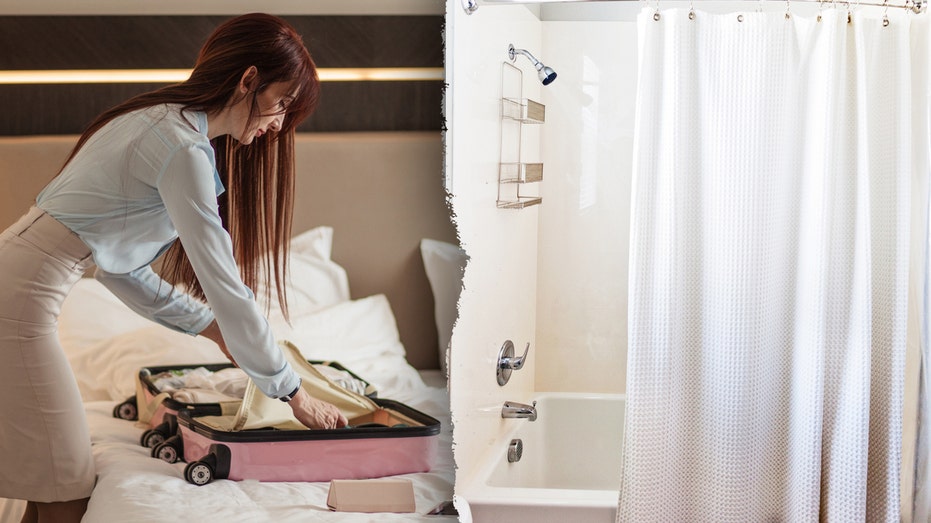
A bug expert in Pennsylvania says to store your luggage and its contents in this unusual location at your hotel or homestay if you want to avoid bringing back any unfavorable pests, like bed bugs.
An expert is speaking out about the best place to store your luggage in order to avoid bringing creepy crawlers home after home rentals or hotel stays.
Eric Braun, a Pennsylvania-based, board-certified entomologist and experienced technical service manager at Terminix, has 27 years of experience and when it comes to traveling, he has advice that he says you should follow.
“I always recommend leaving as much as possible in the suitcase. Only unpack the essentials,” Braun told Fox News Digital.
AFTER TRAVEL, WAIT TO UNPACK YOUR SUITCASE, DOCTOR INSISTS IN UNSETTLING SOCIAL MEDIA POST
“Personally, I place my toiletries on the bathroom counter, hang clothes that need to be hung in the closet and then leave everything else in my suitcase and place my suitcase in the bathroom,” he added.
While the bathtub and shower might seem like an unusual place to store your luggage, Braun has a good reason for putting your extra belongings in this specific location, he said.
Braun said he does not unpack in the bathroom, but simply places his suitcase in there after unpacking the important stuff.
‘AIRPORT MALARIA’ ON THE RISE IN EUROPE, NEW STUDY SUGGESTS: HERE’S WHAT TRAVELERS SHOULD KNOW
“Bed bugs prefer soft or textured materials, so they are less likely to be found on the smooth, hard surfaces typical of bathrooms, such as bathtubs,” Braun said.
“If clothes are left inside the suitcase and placed on the floor, near the bed or within the radius of potential hiding spots for bed bugs, then the suitcase and its contents can be at risk for hitchhiking bed bugs.”
Braun also suggested that travelers store luggage in other areas of the bathroom, on a coffee table or on a desk.
Contrary to popular belief, bed bugs are not attracted to things that are dirty, Braun said. So, the state of cleanliness of a luxury or budget-friendly hotel does not play a part in whether you might contract bed bugs.
AIRLINE PASSENGERS COULD BE REMOVED FROM FLIGHTS FOR GOING BAREFOOT: ETIQUETTE EXPERT WEIGHS IN
“They are attracted to the carbon dioxide humans exhale and the warmth and odor of our bodies, not the cleanliness of our surroundings,” he noted.
While you might want to unpack your bags on the luggage holder, the straps under the suitcase holder have been found to hide the portable pests.
For more Lifestyle articles, visit www.foxnews.com/lifestyle
Last month, Dr. Jason Singh, a Virginia-based primary care physician, shared a PSA asking people on social media to be “lazy” and to not unpack their luggage for up to 10 days to avoid a bedbug infestation.
“Now, if your suitcase remains closed and undisturbed for at least two weeks, well, any bedbug egg or nymph present will likely die due to starvation or desiccation, so now you have a reason to be lazy, just like me,” he said in his video.
After Singh’s video went viral, Braun spoke with Fox News Digital about the concern of bringing bed bugs home after traveling.
Braun advised travelers not to bring an assumed infested suitcase into a living space, but rather keep it outside the home before placing the clothes in a trash bag and immediately into a laundry room.
Below, read more tips from Braun, who offered insights about tracking down pests.
1. Mattress, box spring, headboard and bed frame
Braun recommends examining the sheets for possible “fecal spots” or bed bug droppings, which can look like someone touched the surface of the fabric with a black marker.
“Carefully inspect the mattress and box spring seams, creases, edges, folds, tufts, and around zippers and tags for shed skin and bugs. Lift the mattress to inspect the underneath side and the slats, rails and platform corners of the bed frame. Inspect any cracks, crevices, edges and intricate designs in the headboard,” he said.
He also suggested pulling back the headboard from the wall to examine the backside of the furniture.
2. Floor and baseboard coverings
It is best to scan the carpeted floor and baseboards underneath the bed and the perimeter of the room.
3. Upholstered seating
Look closely at the additional throw pillows in your hotel rooms, specifically the zippers, seams and folded edges along furniture crevices.
CLICK HERE TO SIGN UP FOR OUR LIFESTYLE NEWSLETTER
Braun said people should check the removable lids found on ottomans and stools.
Carefully examine throw pillows, particularly zipper areas, and check the seams, edges and folds along furniture crevices and inside cushion covers of sofas and chairs. Don’t forget any removable lids of ottomans or stools
4. Nightstands and wall fixtures
In the same way that Braun does not recommend placing your clothes in dressers when traveling, he encourages travelers to examine the drawers in the room and other cracks and crevices within the furniture bugs might get into.
“Open and shake any books that may be in the drawers. Observe the edges, backside and underneath lamps, picture frames, alarm clocks or other decorative items and fixtures,” Braun said.





